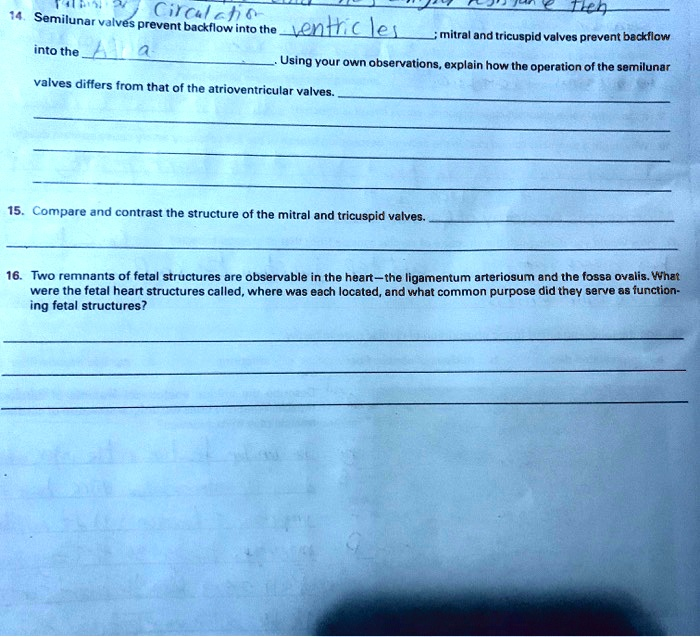Semilunar Circle valves prevent backflow into the aorta and pulmonary artery. The mitral and tricuspid valves prevent backflow into the atria. Using your own observations, explain how the operation of the semilunar valves differs from that of the atrioventricular valves. Compare and contrast the structure of the mitral and tricuspid valves. Two remnants of fetal structures are observable in the heart – the ligamentum arteriosum and the fossa ovalis. What were the fetal heart structures called, where was each located, and what common purpose did they serve in functioning fetal structures?

1. Operation of Semilunar vs. Atrioventricular Valves: Semilunar valves—namely the aortic and pulmonary valves—are located at the exits of the ventricles, leading to the aorta and pulmonary artery respectively. These valves open during ventricular contraction when pressure inside the ventricles exceeds that in the arteries, allowing blood to exit the heart. When the ventricles relax, the drop in pressure causes the semilunar valves to close, preventing arterial blood from flowing backward. In contrast, atrioventricular (AV) valves, including the mitral and tricuspid valves, are positioned between the atria and ventricles. AV valves open when the atria contract and pressure in the atria exceeds that of the ventricles. They close as the ventricles contract to stop blood from regurgitating into the atria. Notably, AV valves are anchored by chordae tendineae and papillary muscles which prevent valve prolapse.
2. Structure of Mitral vs. Tricuspid Valves: The mitral valve, also referred to as the bicuspid valve, has two leaflets and is located between the left atrium and left ventricle. The tricuspid valve, situated between the right atrium and right ventricle, has three leaflets. Both valves serve a similar function, yet they differ structurally due to the different pressure environments of the left and right sides of the heart. The mitral valve is more robust to withstand higher pressures from the systemic circulation.
3. Fetal Heart Structures and Their Purpose: The ligamentum arteriosum is the adult remnant of the ductus arteriosus, which connected the pulmonary artery to the aorta in the fetus. The fossa ovalis originates from the foramen ovale, an opening between the right and left atria. Both features allowed blood to bypass the nonfunctioning fetal lungs, ensuring efficient oxygenation from the placenta during fetal life.
